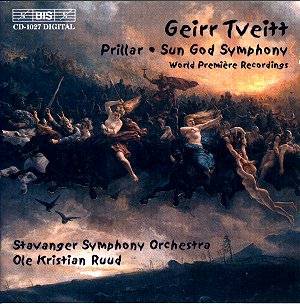Tveitt's
fortunes as a composer have stood much higher over the last five
years. The fact that there are several Naxos CDs has boosted his
coverage greatly; no doubt there will be more. This CD has unjustly
dwelt in shadows. Bis's decision to include it in their 30th Anniversary
Edition with a newly designed card slipcase is a wise move. The
music strongly merits promotion.
We
have read many times the tragic story of the loss of Tveitt’s
manuscripts in a catastrophic fire at his farmhouse in 1970. It
is however worth reminding ourselves
of his education and background. He entered the Leipzig Conservatory
in 1928 studying composition with Hermann Grabner and Leopold
Weninger and piano with Otto Weinreich in 1932. His First Piano
Concerto was premiered by the Leipzig Radio Symphony in 1930.
1932 and 1933 saw him in Paris and Vienna in company with Schmitt,
Marx, Honegger, Villa-Lobos and Wellesz. He returned to Norway
in 1933 and there developed a strong folk-informed style.
Prillar
is a reference to a folk instrument - a goat's horn with
a juniper reed. The rhapsodic three movement piece was intended
as the start of an even larger project which never went any further.
Ironically the score survived due to the composer's failure to
get it performed. He ripped the score up and left the shreds in
a barn. The barn survived the fire and the pieces were painstakingly
assembled and any gaps filled by Jon Øivind Ness. Apart
from the fact that it uses more sanguine and playfully vigorous
music it can be compared in spirit with Joseph Marx's Natur-Trilogie
(recently recorded on ASV). It is obstinately tonal, heavily reliant
on melody with materials and styles of treatment that will remind
you of Sibelius (Pohjola's Daughter and Nightride and
Sunrise), Peterson-Berger (Second Symphony), Canteloube (the
orchestral voices in the Chants d'Auvergne), Ravel (Rapsodie
Espagnole) and Nielsen (middle movements of symphonies 3 and
4). There is even a hint of the barbaric triumph of a Williams
or Rózsa score mixed with the angular storms and upheavals
of Jon Leifs.
In
1938 Tveitt's 90 minute work Baldur's Dreams was performed
in its full orchestral version in Oslo. It was making tentative
concert hall progress outside Norway but the war intervened and
sank it almost completely. The full score was another victim of
the 1970 fire but two recordings and a piano version survived.
From these Kaare Dyvik Husby has reconstructed the score of the
Symphony from these sources. The three movements are from the
third act of Baldur's Dreams.
The
Sun God Symphony, drawn from Baldur's Dreams,
is in three movements: The Gods forget the mistletoe;
Baldur's Bonfire Journey; Arrow-Dance. Pohjola's
Daughter by Sibelius is only the roughest approximation of
the soundworld here which is noticeably tauter than in Prillar.
The structure has the sense of discipline and cohesion absent
from Prillar. The stubborn angularity and the drum thuds
of the middle movement take us to Jon Leifs' orchestral pictures.
The final movement portrays the shoals of arrows fired at the
‘invincible’ Baldur until Baldur's brother, Hod is tricked into
firing an arrow made of wood from the mistletoe. Sure enough this
finds the Nordic Achilles Heel and kills our hero in a
coruscating blaze of Bartókian pyrotechnics and a groaning
growl like that at the end of Ravel's Bolero.
These
are world premiere recordings and they give every sign of being
definitive. I never once doubted the intensity or conviction brought
to this extraordinary and accessible music. Another gloriously
enterprising choice to mark Bis's Thirtieth Anniversary.
Rob
Barnett
